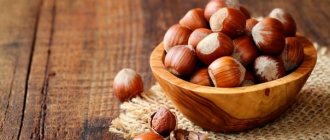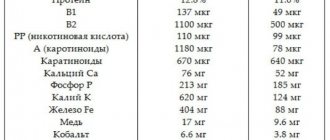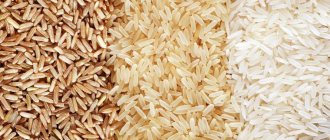Eco-trends for healthy eating continue to excite the minds of the population and are gaining an increasing number of supporters. Among the most current trends is the consumption of green “live” buckwheat, which has come to replace the traditional heat-treated grain.
While the media is praising green buckwheat and presenting this cereal as a panacea for all diseases, let’s figure out what its real benefits are, what it contains, and whether you can lose weight with it.
What is green buckwheat?
Not everyone knows what green buckwheat is, how it differs from regular buckwheat and why the benefits of consuming it are so great. The main difference is in the processing features of the product. After harvesting, buckwheat is steamed or fried. As a result, it acquires a characteristic brown tint and a bright taste.
If the grains do not undergo heat treatment, it retains its natural green tint. During heat treatment, the product loses some of its nutrients: it is for this reason that green buckwheat is considered a more valuable food product than brown buckwheat.
Features of the cereal
The main value of this cereal is that it is an unprocessed product . That is why it is also called live buckwheat. Unlike ordinary buckwheat, which is present in the kitchen of every housewife, green buckwheat has retained almost all the valuable substances that nature has endowed it with. Few people know, but until the 50s of the last century, in the Soviet Union, buckwheat was not processed and was supplied to store shelves in green form.
If the green river is healthier from a food point of view, then why process it? The thing is that fresh product has a short shelf life . When processing buckwheat grains, they are exposed to high temperatures to destroy any remaining pesticides and fungicides used to grow the plant. But, unfortunately, most of the vitamins and beneficial microelements are destroyed along with them.
Be sure to read about the interesting differences between green and brown buckwheat that we have no idea about!
Chemical composition of the product (vitamins and microelements)
Green buckwheat contains the following vitamins:
- vitamin A, good for vision;
- B vitamins necessary for the normal functioning of the nervous system;
- Vitamin E is a natural antioxidant that allows you to preserve the beauty of your skin and hair for a long time;
- vitamin PP, which is involved in all types of redox reactions occurring in the body. This vitamin accelerates metabolic processes and promotes weight loss.
The cereal contains a number of valuable microelements:
- sodium and potassium, necessary for normal functioning of the heart muscle;
- iron, which helps avoid iron deficiency anemia;
- zinc, involved in the process of hematopoiesis;
- phosphorus, vital for the normal functioning of the liver, brain and heart;
- cobalt, which accelerates the absorption and absorption of iron.
The product also contains amino acids, eight of which are classified as essential. Green buckwheat contains approximately 15% protein.
Important! It has been proven that eating green buckwheat normalizes hemoglobin levels.
Therefore, its use is indicated for anemia, as well as during the recovery period after serious surgical interventions associated with massive blood loss.
Medical use
Traditional medicine recommends a decoction of kernels for dry coughs and for the treatment of colds, as they say in ancient recipes.
- Buckwheat porridge was used to restore blood in case of great loss.
- Poultices and ointments were made from flour for skin diseases (eczema, boils, abscesses), and applied to small wounds.
- Flour mixed with buckwheat leaves was used as powder for babies.
- Chinese medicine recommends kernel tea to reduce blood pressure.
Recipes for treatment with buckwheat seeds
For treatment, use only unroasted cereals (green seeds). In addition to seeds, buckwheat shoots and leaves are used.
For stagnation of bile, pancreatitis, poisoning, high sugar, drink kefir with buckwheat flour. Mix 15 g of flour per glass of kefir and leave overnight. Eat it in the morning instead of breakfast. So for 30 days, after which the same break is taken.
For chronic fatigue, anemia, and weakness, after washing, the cereal is lightly dried in a frying pan and crushed. Flour is taken a day, up to four times, 30 grams, washed down with water or milk. Take between meals.
- To strengthen the heart and blood vessels, buckwheat jelly is cooked as a preventive measure for atherosclerosis . Why it is useful, how to prepare it, read the article: Buckwheat jelly cleanses the body and heals blood vessels.
to heal wounds, boils and abscesses . Pour buckwheat grain flour (45 g) with celandine decoction (50 ml). Apply the resulting paste to the affected areas of the skin for 10-15 minutes, 3-4 times a day.
Beneficial properties of sprouted green buckwheat
An important difference between unfried green cereal and regular buckwheat is that it is alive and can be sprouted. In the sprouts of any seeds, the amount of vitamins necessary for the start of a new plant increases several times.
Buckwheat seeds increase the concentration of vitamins B, E, and antioxidants. The process of vitamin C synthesis starts. Interestingly, while the seed is at rest, this vitamin is almost absent.
Sprouted buckwheat, when consumed regularly, saturates the body with useful elements and vitamins, increases energy and vitality. Strengthens the body's defenses, resistance to negative manifestations of the external environment, and endurance. Therefore, green buckwheat sprouts and seeds, as a dietary product that is easily digestible, are recommended to be included in the diet:
- athletes,
- people who lead an active lifestyle with daily physical activity,
- those who need support for the body (during the period of rehabilitation after operations and serious illnesses).
- children.
How to germinate grains
The germination procedure is simple. First, you need to sort out the grains, free them from debris, fill them with water, and remove all floating grains. This is an unripe grain (weakened) or with a damaged embryo. It won't sprout. Keep the cereal in water for about an hour to swell, then rinse, spread it on a damp cloth and cover with a damp cloth on top.
Or just leave it in a container, covering the top with a damp cloth. Soak the cereal for 20-24 hours, making sure that the top napkin is damp, otherwise the sprouts will dry out. Sprouted grains are stored in the refrigerator for no more than three days. They are washed before use.
Sprouts are used in porridges and salads. Can be mixed with yogurt, kefir. By grinding the sprouts, you get a delicious sauce; you can add spices, nuts, and herbs to it.
They are recommended to eat to support health, especially in case of diseases:
- vitamin deficiency,
- obesity,
- anemia,
- inflammation of the gallbladder,
- arthritis,
- with poor vision,
- atherosclerosis,
- ischemic disease,
- varicose veins.
Do green grains have contraindications and harm?
Rutin, which strengthens the walls of small vessels, is not always useful and can be harmful to health. Due to its blood thickening feature, it is especially dangerous for people with increased coagulability.
The fiber contained in cereals increases gas formation. If you have problems with intestinal bloating, then you need to accustom your body to small portions.
Given this reason, you should not give porridge made from green grains to small children.
A mono-diet on cereals is also harmful to health. Long-term use of one product creates an excess of some substances and a deficiency of others. Such nutrition does not bring benefits to the body; it should be varied. Buckwheat has no other contraindications.
Properties of green buckwheat
The composition of green buckwheat is unique. In particular, it contains proanthocyanidin, which has the property of blocking the growth and division of cancer cells. Due to this property, the product is recommended both for the prevention of cancer and during its treatment.
Contains cereals and bioflavonoids, which have a beneficial effect on the cardiovascular system. They remove cholesterol from the body and help prevent atherosclerosis, due to which, with daily consumption of green buckwheat dishes, the likelihood of developing a heart attack and strokes is reduced by 20%.
Benefit
The product has the following effects on the body:
- relieves constipation by enhancing intestinal motility;
- normalizes blood pressure;
- activates brain function;
- helps cope with insomnia and loss of strength;
- helps improve immunity;
- For people who do not eat meat, green buckwheat will help fill the protein deficiency in the diet;
- prevents a sharp increase in blood glucose levels. The cereal contains so-called slow carbohydrates, which create a long-lasting feeling of fullness.
Important! Green buckwheat brings great benefits. However, how to consume it and how to prepare it depends on the state of the body. Therefore, if you have serious illnesses, you should consult your doctor before introducing this product into your diet.
For women
Regular consumption of unprocessed buckwheat improves skin condition: shallow wrinkles and age spots disappear. The product can be used not only for food, but also as a face mask.
The cereal contains folic acid, which normalizes the functioning of the female reproductive system. It is especially indicated at the beginning of pregnancy, promoting the proper development of the fetal nervous system. At the same time, green buckwheat helps prevent anemia, which often develops in pregnant women.
For men
Green buckwheat is a product that increases potency and fertility in men. This is due to the high content of zinc, which improves the functioning of the gonads.
If a man is engaged in strength training or his work involves physical activity, green buckwheat is necessary to replenish the body's energy resources. It also contains a large amount of amino acids (threonine, arginine, etc.), which promote muscle gain.
For children
The product can be given to children from seven months of age. The product is perfectly absorbed and almost never causes allergic reactions. In children, buckwheat normalizes intestinal function, facilitates peristalsis, promotes full development and strengthens the immune system.
Important! Green buckwheat strengthens the immune system, so its use is especially indicated during seasonal epidemics.
Mineral composition
Green buckwheat is thermally untreated buckwheat grains , which contain an expanded range of nutrients, including:
- Cellulose . A substance that is also called “dietary fiber”. This element helps to absorb other nutrients, stimulates the functioning of the gastrointestinal tract, normalizes digestion and is recommended for those people who have problems digesting or consuming certain foods;
- Calcium. It is good for bones, nails, hair, teeth, regulates the functioning of the kidneys and urinary system. Its deficiency causes swelling and poor fluid outflow.
- Magnesium . Regulates the strength and intensity of muscle contractions and the functioning of the cardiovascular system.
- Sodium . Affects water-salt metabolism, the functioning of the lymphatic system, the strength and patency of impulses.
- Potassium . Stimulates metabolic processes in the liver and kidneys, helps the gallbladder work.
- Phosphorus . It is a resource for the functioning of the brain and spinal cord, increases the volume of gray matter, improves memory.
- Chlorine _ It is a stabilizer of the biochemical composition of blood.
- Sulfur . An element that makes up about 2% of the composition of all body tissues. Most people have a deficiency of this substance, which causes lack of sleep, fatigue, and nervous disorders.
Harm and contraindications
Green buckwheat has virtually no contraindications. It is not recommended for people who are allergic to regular brown buckwheat. Nutritionists also recommend limiting the consumption of the product if there is increased blood clotting.
Eating a large amount of the product can cause increased gas formation in the intestines.
Important! In the presence of chronic diseases of the stomach and intestines (gastritis, colitis), the product is introduced into the diet, starting in small volumes (starting from one tablespoon).
Harm of green buckwheat
The benefits of green buckwheat are undoubtedly great, but consumption of the product does not cause harm. Only in rare cases and if buckwheat is used incorrectly, some problems may occur.
If the product is not properly prepared for use, or if it is not thoroughly cleaned of mucus accumulated during soaking, undesirable sensations may appear in the intestines and stomach. The product may also cause the formation of excessive gas and black bile.
It is not recommended for children to eat cereals due to the possible occurrence of constipation. In addition, green buckwheat can be harmful to a person with increased blood clotting due to the high amount of rutin in it
People with complex intestinal and stomach diseases should also be careful when going on product-based diets. In this case, competent consultation with a doctor is required.
In general, the benefits and harms of the product cannot be compared. The latter is practically absent, and proper use of the product has only a positive effect.
The beneficial properties of green buckwheat contribute to the treatment and prevention of various diseases, help in the fight against excess weight and have a very healing effect on the body as a whole. Therefore, the benefits of green buckwheat are absolutely obvious and are not in doubt.
httpv://www.youtube.com/watch?v=embed/FEUeZXQfs14
- What foods to eat to keep your lungs healthy
- The great benefits of water for our body
- Which foods have the most healthy carbohydrates?
How to germinate green buckwheat at home?
It is very easy to germinate grains:
- the grains must be sorted, removing all possible impurities and selecting only intact ones, and rinsed under running cool water;
- The washed grains are placed in a glass container and filled with boiled or purified water. There should be enough water so that the grains are covered by 1 - 1.5 cm. The grains should be soaked for 5-6 hours;
- the grains are washed again and left in a colander for 1 hour. The buckwheat must dry out, otherwise fermentation will begin;
- buckwheat is placed in a container in a layer of no more than 4 centimeters (if the layer is thicker, oxygen access will be difficult). The container is covered with a lid, leaving a gap for air access. Instead of a lid, you can use gauze folded in several layers.
Sprouts will appear within 10-12 hours. After this, the grains will be ready for consumption.
Sprouted green buckwheat should not be stored for more than 2 days.
Sprouted buckwheat has a delicate sweetish taste. It can be eaten either in its natural form or as part of vegetable and fruit salads, as well as cocktails. You can add grains to cold soups or sauces.
Important! During heat treatment, sprouted grains lose some of their nutrients.
Energy value
The calorie content of green buckwheat is 310 kcal per 100 grams, which is 23.5% of the norm. It is a fairly high-calorie product, but we are talking about useful slow calories that fill the body with food energy reserves.
This supply is not stored in the form of harmful substances, but is spent on the functioning of the body and its organs.
BZHU indicators are given in the following table:
| Quantity in grams | % per 100 grams | |
| Squirrels | 12,6 | 15,4 |
| Fats | 3,3 | 5,1 |
| Carbohydrates | 62,1 | 48,5 |
It is also important to know the glycemic index (GI) of green buckwheat, which, compared to other types of cereals, is the lowest. Before talking about numbers, it’s worth understanding what the glycemic index is and what significance it has for health. GI is the rate at which carbohydrates are digested. The higher the number, the higher the speed. Accordingly, the metabolism is disrupted, the body simply does not have time to absorb all the incoming substances, and they are deposited as empty cargo in the blood, internal organs, and fat folds.
For example, regular processed buckwheat has a GI of 50, and green buckwheat has a GI of 15. This means that when entering the human body, buckwheat grains are absorbed slowly, as a result of which all nutrients are evenly distributed throughout the organs. Due to this, the feeling of hunger does not occur for a long time, which is important when dieting.
Features of the use of green buckwheat
Green buckwheat, the benefits of which are described above, can be used for preparing all kinds of dishes and as a traditional medicine.
Let's look at the ways to use this product in more detail.
In cooking
Nutritionists say that during heat treatment, green buckwheat loses some of its beneficial properties. Therefore, the cereal should either be steamed, or just brought to a boil and immediately removed from the heat, leaving for an hour for the porridge to brew. You can also pour boiling water over buckwheat in a thermos overnight: in the morning you will get a tasty, nutritious and very healthy breakfast.
Those who want to lose weight are recommended to eat buckwheat with berries and dried fruits as a breakfast. This dish speeds up metabolism and creates a long-lasting feeling of fullness. The cereal goes well with cheeses, pates, and you can even use it as a filling for pies and pies. Sprouted grains go perfectly with honey and nuts.
Folk recipes based on green buckwheat
Green buckwheat is a product that helps not only maintain health, but also cope with certain diseases.
For liver diseases
Buckwheat is considered one of the best foods for maintaining liver health. It cleanses it, removes toxic substances and protects it from damage.
To prepare a “folk medicine” for liver diseases, add 200 ml of hot water to a tablespoon of cereal and leave it in a thermos for 10 hours. The water is drained, and the grains are taken on an empty stomach. After this, you can eat food after at least an hour and a half.
For diabetes
Green buckwheat, the benefits of which have been proven for diabetes, is useful for diabetes, and its preparation for this disease has some peculiarities. Cereals contain many vitamins, fiber and microelements, and they do not lead to a sharp increase in blood glucose levels. It is important to remember that every day people suffering from both type 1 and type 2 diabetes can eat no more than eight tablespoons of porridge.
Diabetics should not cook the cereal, but brew it with boiling water and leave it in a thermos for 8 hours. Green buckwheat with kefir is especially useful for diabetes. You can prepare it in the following ways:
- pour 4 tablespoons of ground grains into a glass of water and leave to steep for two hours. After this, the container with buckwheat is placed in a water bath for an hour. The finished porridge must be divided into three servings and consumed before breakfast, lunch and dinner, after mixing with a glass of kefir;
- In the evening, ground cereal in the amount of one and a half tablespoons is poured with kefir and left in the refrigerator. The resulting dish is divided into two parts and consumed an hour before breakfast and an hour before dinner.
For cancer
Sprouted grains, which contain a large amount of bioflavonoids, are useful for cancer. The amount of bioflavonoids in the product is maximum on the 6th day after germination.
Daily consumption of sprouted buckwheat in the amount of two to three tablespoons is recommended for prostate, breast and intestinal cancer.
In home cosmetology
Green buckwheat, the beneficial properties of which are described above, is a product that can be used to maintain beauty and rejuvenation. Here are some simple recipes:
- mask for dry skin. The sprouted grains are thoroughly crushed. A tablespoon of flour is mixed with a teaspoon of liquid honey and the same amount of grape seed oil. The mixture is applied to the face for 20 minutes;
- mask for oily skin. The cereal is crushed and poured with hot water in a ratio of 1 to 2. The mixture should be infused for 8-9 hours. After this, the cereal is mixed with egg white and applied to the face. If you have skin rashes, you can add a drop of tea tree oil to the mask (if you are not allergic);
- mask to normalize the condition of the scalp. The crushed grains are mixed with water in a ratio of 1 to 3. The mixture should infuse for 8 hours. After this, the resulting mask is applied to the hair roots for an hour. To ensure that the mask not only strengthens and nourishes the hair follicles, but also accelerates hair growth, you can add one ampoule of nicotinic acid to it.
How to eat grains correctly
In order for all the valuable microelements in the cereal to be preserved and enter the body with food, buckwheat must be cooked correctly. In most cases, people boil or stew . So, boiled buckwheat is a useless product that will bring neither harm nor benefit to the body. High temperature will simply kill all active substances. Therefore, it is recommended to eat buckwheat raw or sprouted .
One way to prepare nutritious buckwheat for breakfast: in the evening, pour a few tablespoons of peeled cereal into a glass of kefir and cover. By morning you will receive a cup of delicious and healthy buckwheat porridge.
A popular way to prepare green buckwheat is to sprout it.
What are the benefits of sprouted buckwheat?
First of all, sprouting destroys phytic acid , which is found in large quantities in plant grains, nuts and legumes. This acid comes into contact with all minerals entering the body and takes them away. That is, calcium, iron, zinc and other minerals are absorbed by phytic acid before they can benefit human organs.
In addition, even the smallest sprouts obtained as a result of germination help to break down complex substances, such as sugar and fats, into simple ones .
Selection and storage
High-quality green buckwheat has a greenish tint and is light in shape. The cereal should not have any foreign odors. If it smells like mold, it means the product was stored at high humidity and is unfit for consumption, as it can cause harm to the body. The best grains are those produced in Europe (Austria and Germany).
Buckwheat should be stored in an airtight container in a dark, dry place. After purchasing, it is advisable to consume the cereal within one month.
Green buckwheat, the benefits of which are described in the article, is a unique useful product that can improve the condition of the body, slow down the aging process, lose excess weight and even slow down the growth of a malignant tumor. Try introducing this unique product into your diet and you will quickly notice the results!
How to choose a quality product
Green buckwheat is positioned as a healthy food product; it is more expensive than regular buckwheat. The issue of choosing a quality product becomes of fundamental importance.
The first selection criterion is the origin of the product . Since buckwheat is one of our traditional grains, it is best to choose domestically produced grains.
It is better if it is packaged in transparent packaging so that the buyer can see the contents. Packaging with a transparent window is acceptable.
The color of high-quality cereals should be soft green ; brown or bright green shades are unacceptable. If foreign impurities are noticeable among the grains (pebbles, fragments of stems, leaves, etc.), it is better to look for grain from another manufacturer.
Green buckwheat is a live grain. This is a grain that has retained the ability to germinate. Accordingly, there should be no grains with mechanical damage. The permissible percentage of damaged kernels is no more than 1%.
Buckwheat grains must have the same size ; the presence of kernels of different sizes is not allowed. The packaging label for buckwheat indicates GOST 5550-74.
It is difficult to remember all current standards. It is enough to know that buckwheat groats are not of the highest grade. GOST prescribes the criteria for dividing into first, second and third grades.
The inscription “Highest grade” on the packaging of buckwheat is an advertising ploy.
Check the expiration date . For buckwheat, it does not exceed one year, and is counted from the date of manufacture, which may not coincide with the date of packaging. The shelf life of green buckwheat is less than a year.
Cereals that have expired or are packaged in violation of technology have a distinct musty odor, and the grain acquires a sour or bitter taste.
When purchasing packaged products, you can evaluate the smell and taste of the cereal only after purchasing the product.
Prunes for constipation - how to use? Read our article.
The harm and benefits of raisins for children are discussed in detail in this publication. Find out more!
You can learn about the beneficial properties of canned pineapple from this article.











